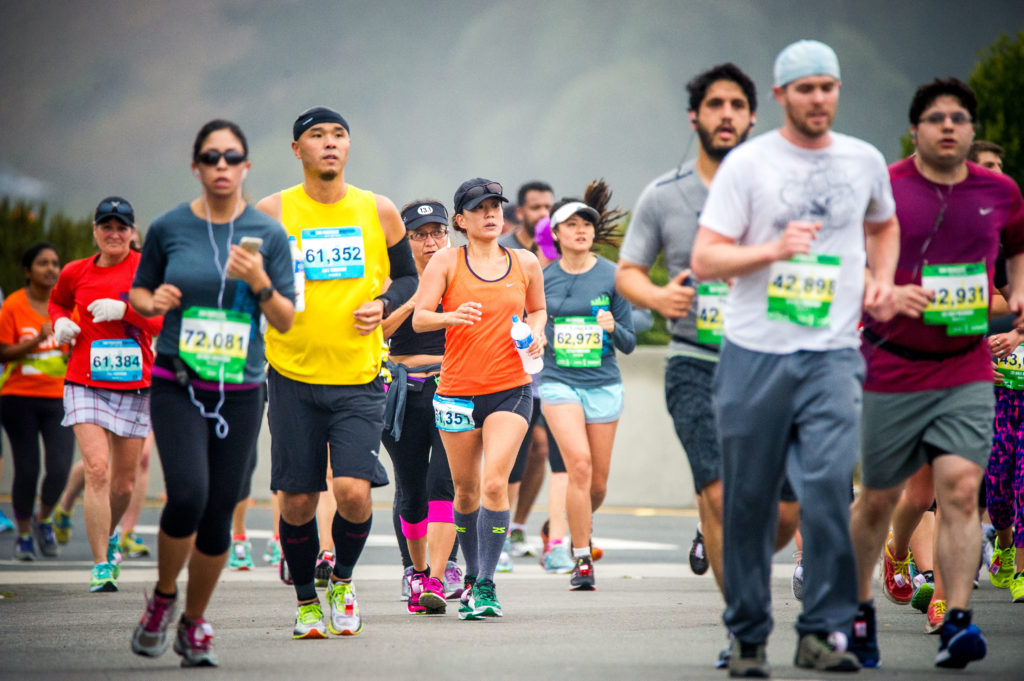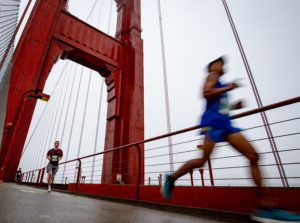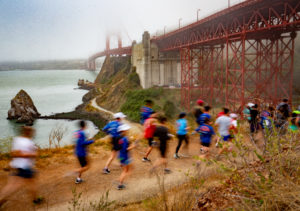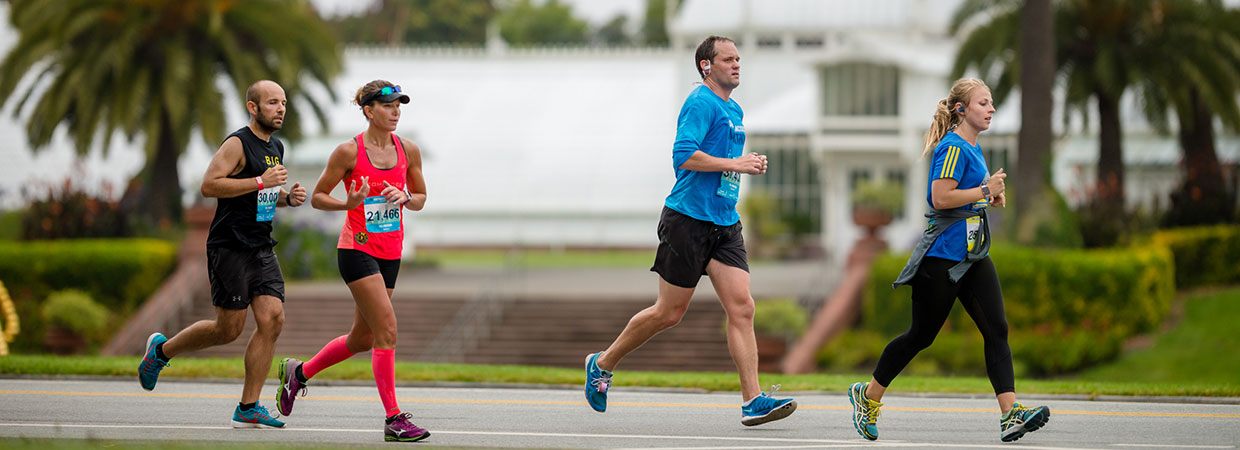Dos and Don’ts of Training for The Biofreeze San Francisco Marathon
Contributed by Erin Garvey, a 2017 Ambassador for The Biofreeze San Francisco Marathon.
With 100 days to go until race day at The Biofreeze San Francisco Marathon (or 5K, Half Marathon, or Ultramarathon), for many of us, if we haven’t already begun our training, it’s probably about time we do so. While many runners who flock to run in San Francisco are local to the Bay Area, many more are not, and in fact, the races actually attract many international visitors, too. Similarly, while many people who run any of the races at The Biofreeze San Francisco Marathon are veteran runners, many more are more comfortable characterizing themselves as novice runners, folks who are seeking to accomplish a lofty and laudable lifelong goal.
Given this great cross-section of people who will be gracing the streets of San Francisco in late July, I wanted to share with you all some dos and don’ts of training for The Biofreeze San Francisco Marathon events. I’m happy to share that I’ve run The Marathon twice now and the 5K once, so I’m basing all of my advice on my own personal experiences.
 Do: actually train. Maybe this is a given, but surprisingly, a lot of people think they can show up to the start line of a 5K, Half Marathon, Full Marathon, or an Ultramarathon and just wing up, hoping for the best (yeah, I know — crazy, right?). If you register for an event and later find that you can’t complete the distance, consider downgrading to a shorter race. (Note: you may not be able to do this if the other race is already sold out.) Granted, you could just go for broke and race the longer distance that you’re not physically trained to handle, but you probably want your experiences in San Francisco to be rewarding and memorable, not gruesome and painful.
Do: actually train. Maybe this is a given, but surprisingly, a lot of people think they can show up to the start line of a 5K, Half Marathon, Full Marathon, or an Ultramarathon and just wing up, hoping for the best (yeah, I know — crazy, right?). If you register for an event and later find that you can’t complete the distance, consider downgrading to a shorter race. (Note: you may not be able to do this if the other race is already sold out.) Granted, you could just go for broke and race the longer distance that you’re not physically trained to handle, but you probably want your experiences in San Francisco to be rewarding and memorable, not gruesome and painful.
Do: include some hill work in your training. The first time I ran the Full Marathon here, I was living in the flattest of lands — Chicago — and literally would drive about 40 minutes outside the city limits to get to train on anything that resembled a hill. Even if you have to resort to running on “treadmill hills” or in parking garages, something is better than nothing. San Francisco’s hills are completely runnable, but they are still challenging, and it’ll be in your best interest to do even a teensy, tiny bit of training on some where you live.
Do: connect with other runners (and ideally, folks training for San Francisco). If you’re local, come to any of the many meet-ups the other ambassadors and I will be hosting, along with Run365, at many of the local area running stores. If you’re not local, don’t worry: just come move here! (Kidding… kind of…) If you’re not in San Francisco, seriously consider jumping in with a local training group near you so you a) have some accountability to show up for your weekly long runs and b) so you can make some new running buddies! Running is a ton of fun when you make it a social thing, and who knows? Maybe you’ll even be able to convince some of your new-found buddies to come run San Francisco with you. (And when you’re busy logging your miles online after your runs each week, consider also joining this Strava group just for folks training for any of The Biofreeze San Francisco Marathon events.)

Do: roll with your training, even when the summer elements make it seemingly impossible. Late July in San Francisco is very different from late July elsewhere in the USA (or the world, for the matter), so while you might find yourself sweating through the suffocating humidity or unbearable heat, remember that it’ll be different — and more runner-friendly — in San Francisco come race day. In your spring and summer training, do the best you can wherever you are, put in a good effort with your training, and you’ll be fine. There are many things that we can control, but unfortunately, the weather isn’t one of these things. Roll with it when the going gets tough (or miserable).
Do: listen to your body!!! The bold and triple exclamation marks belie the utter importance of this statement. When you are putting your body through the grueling and taxing work of training for an endurance event, the least you can do is heed its warnings it throws to you when things aren’t feeling great. You’ll quickly learn to differentiate between pain and discomfort — and yes, there is a difference — and if you are feeling sub-par for more than a couple days, shut things down, and nip it in the bud. It’ll be worth it in the long run.

Don’t: sell yourself short. You want to do this awesome thing of running a 5K, Half Marathon, Marathon, or Ultramarathon? Good for you! Go get it, friend!! Put whatever preconceived notion of your so-called limitations behind you. With the right training, anyone — and I do sincerely mean anyone — can finish an endurance event like those that The Biofreeze San Francisco Marathon offers. Don’t tell yourself that you’ll do it in five years from now; seriously, if you want to do it in 2017, get after it! (Plus, since this year marks the race’s 40th anniversary, you might even want to consider committing to the 2017 and 2018 races. How’s that for long-term motivation?!) Be your own biggest cheerleader and advocate.
Don’t: take yourself too seriously. Unless your ability to pay your mortgage hinges on your performance at any of The Biofreeze San Francisco Marathon’s events, honestly, relax. Don’t take yourself (or your training or racing) too seriously. Remember that you’re paying to do this, and you’ve decided to sign up for what you, your friends, or your family might be calling a “crazy event” for some specific reason. Training and racing endurance events can teach us a lot about ourselves, and in the process, they can also show us how much tougher we are than we could have ever anticipated. Even when you have sh-tty training days — and they’ll happen, it just comes with the territory — muscle up, buttercup, and move on. This is supposed to be fun; keep it that way!
Don’t: wait until race weekend to find out what works best for you. One of the best parts of training for an endurance event is the sheer number of opportunities you have to try out different parts of your running — the different pairs of shoes you have, the different clothing options, your nutritional components, and the like — so you should be strolling into race weekend knowing exactly what works for you and what doesn’t. Some people even swear by the adage of “nothing new on race day.” Sure, you might find a great shirt or a killer pair of shoes at the marathon expo, but consider waiting to try those things out until after you’ve crossed the finish line; finding out at Mile 3 that your new stuff rubs your skin to hell would make for a miserable race and memory.
Don’t: train through injury!!! Closely related to an earlier point, it’s so important to listen to your body and not try to run through an injury. Unlike whatever idea you might have, we runners are not invincible beings, and unfortunately, from time to time, we do stupid things to our bodies that make us get injured. Again, if things begin to feel “off” and don’t feel “back to normal” within a couple days, shut it down, and get an opinion from a licensed medical professional, someone who’s not Dr. Google. It’s far better to not run for 2 weeks than it is to not run for 22, and you definitely don’t want to end up being the fittest spectator on the sidelines of the race that you were supposed to run
There’s so much more that I could add on both sides of this conversation, but I think these pieces of advice are good starting points. I hope that your next 99 days of training go over smoothly and injury-free, and I can’t wait to see you on the starting line. You will learn so much about yourself as you go through the process of training for your San Francisco Marathon event — whether it’s your first or your 40th — and with some good solid training under your belt, I have no doubt that you’ll line up at the starting line ready to rumble and that you’ll finish the thing with a smile plastered across your sweaty, glistening face. 🙂


